
While the traditional lock and key is still widely used today, fobs and readers have been the top of the line regarding high-quality access control for the past several decades. While the means have changed over the years, the process has remained relatively the same: a panel near a door scans a card, magnetic strip, or fob sensor, reads the transmitted credentials, and, if approved, grants access. Fobs specifically emanate radio waves that the electronic reader picks up, serving the same purpose as a card without needing to be as precise.
Compared to the lock and key, it isn’t hard to imagine why it has become prevalent for businesses and apartments. Where hundreds of team hours and thousands of dollars each year would go to copying keys and rekeying locks, the fob allows tenants to provide and restrict access to employees and tenants on a broad scale, allowing them to access certain areas vs. denying access to locations they shouldn’t. It is a lot less of a headache to manage, at least compared to what preceded it.
However, as is the case with a lot of technology, the system is quickly becoming obsolete. The reader’s basic programming comes from the firmware inside of it, which holds the list of what fobs are allowed access and not. The firmware is hard to program, and if permissions need to be added or changed, it will have to be manually installed into each reader. This severely limits where apartments can implement these readers, which tends to boil down to communal areas, clubhouses, pools, and amenities. The use of firmware as a credentials reader also raises an issue of propriety: the manufacturer of the reader will only allow their credentials to be used with their reader. This can limit the reader’s usage even more, as property managers need to choose between implementing the hardware in select areas (while using keys for everything else, defeating the purpose of upgrading and resulting in more wasted team hours) or relying on different manufacturers for different access points (forcing managers to juggle numerous fobs and apps). That doesn’t even mention the security risks of people holding on to fobs once they leave a property or getting their hands on fobs that are not theirs.
The solution to this problem is to look beyond the firmware and create hardware-agnostic products. Hardware agnostic is an IT term that, according to Technopedia, is a system “that do(es) not require any special hardware adaptations and can work with different types of systems without suffering compatibility issues.” Regardless of hardware or manufacturer, it can be compatible with external systems, meaning it does not require firmware to read the credentials. Geokey is a hardware-agnostic software that can fit into this role and addresses many of the issues presented by a reader-based system.
Without firmware and a reader, how can Geokey unlock doors
Geokey acts as both the reader AND the credentials, allowing it to unlock a door controller with a simple swipe. Because it is connected to the cloud, the app can unlock the door from anywhere and doesn’t require proximity or a Wi-Fi connection. Property managers can now grant and remove access to users through their phones: no manually updating firmware to readers. This ease allows Geokey integrated hardware to be put anywhere without creating a logistical nightmare
How does this fix the propriety issue?
Geokey only creates software, integrating with various manufacturers and partners to give property owners the access control solutions they need. From door controllers to padlocks and outdoor intercom systems, Geokey and its partners are prepared to fill any gap a business or complex might need. This allows property managers to control everything under a single umbrella and not have to mishmash with other systems or fall back on keys (saving you all those team hours).
Geokey’s hardware-agnostic solution extends beyond hardware integration, as it can also integrate with other software. This can be appealing for apartments that have resident experience apps, which can make requests to see if we can integrate. That way, you can draw traffic to the app and simplify tenant life.
What about security concerns?
Geokey’s access control solution is run through Microsoft Azure, ensuring it is encrypted and secure: only property administrators, tenants, and approved parties will have access. No more worrying about lost or stolen fobs and keys.
On top of this, Geokey allows managers to collect live data on when doors are accessed. The Live Tracking tab will show who is swiping, which access point they unlocked, and when they did it.
Conclusion
With technology continuing to progress, the move to a mobile-based, hardware-agnostic system is the future. While secure, it creates ease of access for tenants and can fulfill the needs of property managers. It gives administrators an umbrella to manage all their access control needs while not being a “one-size-fits-all” approach.
